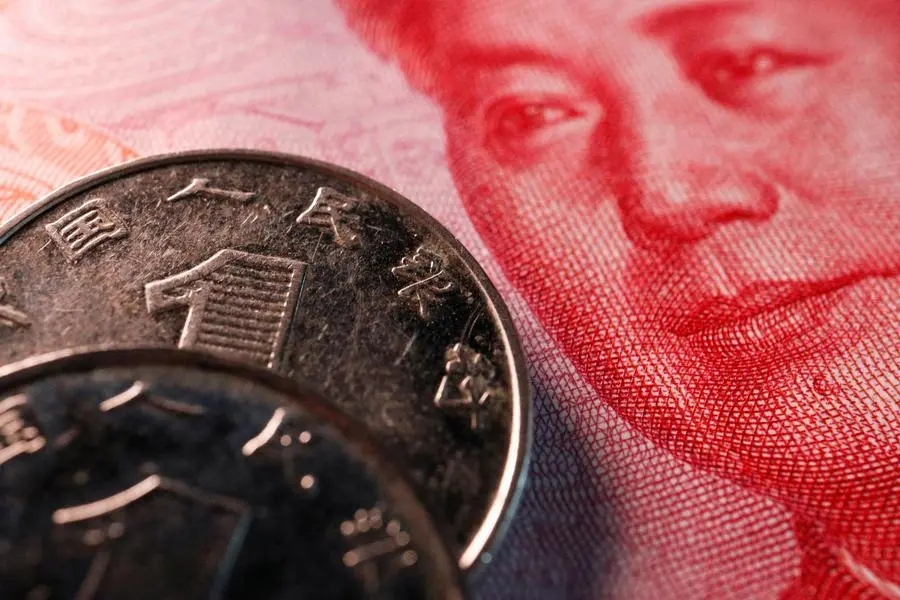PHOTO
China's yuan weakened to a five-month low against the dollar on Friday, pressured by reports of an Israeli attack on Iran that sparked rising safe haven bets. The latest developments prompted concerns over a widening of the Israel-Hamas war in Gaza to include other countries in the Middle East, supporting traditional safe haven assets including the U.S. dollar and gold but jeopardising emerging market currencies.
Initial U.S. news reports late on Thursday said Israel launched missiles at Iran in retaliation for an April 13 attack on Israel that was in response to an alleged Israeli assault that killed Iranian military leaders on April 1. Iranian officials on Friday told Reuters there was no missile attack. "Markets will be very worried that this is the start of a tit-for-tat escalation which could create huge volatility in the Middle East," said Khoon Goh, head of Asia research at ANZ. That has piled additional downside pressure on the weakening yuan, which has lost 2% year-to-date, pressured by its relative low yields versus other currencies and outflows of foreign investment from an anaemic stock market.
The onshore yuan opened at 7.2391 per dollar and eased to a low of 7.2431, its softest since Nov. 17, 2023. By midday, it was changing hands at 7.2426, 44 pips weaker than the previous late session close. Some currency traders said the yuan's losses were rather limited as a senior central bank official told a news briefing on Thursday that China's goal to keep the yuan exchange rate basically stable will not change. "This underscores that the central bank wants to prevent wild swings in the yuan exchange rates as the markets are repricing the timing and size of U.S. Federal Reserve rate cuts this year," said Tommy Wu, senior China economist at Commerzbank.
"While FX stability remains the priority, the People's Bank of China (PBOC) may continue to allow CNY to soften modestly against USD. This is especially given that the currencies of China's trading partners have depreciated against USD, which in turn pushed up the CNY currency basket." Prior to market opening, the PBOC set the midpoint rate , around which the yuan is allowed to trade in a 2% band, at 7.1046 per dollar, weaker than the previous fix of 7.102. Friday's official guidance is the weakest since March 1, but continued to come in much stronger than the market had projected, traders said, interpreting it as an official attempt to rein in yuan weakness.
The persistently firmer-than-expected yuan midpoint fixing has sent the yuan's basket value to a new 18-month high. The CFETS yuan basket index has gained 3.4% to 100.73 as of Friday. As of midday, the global dollar index rose to 106.272 from the previous close of 106.151, while the offshore yuan was trading at 7.2565 per dollar. The yuan market at 0302 GMT: ONSHORE SPOT: Item Current Previous Change PBOC midpoint 7.1046 7.102 -0.04% Spot yuan 7.2426 7.2382 -0.06% Divergence from 1.94% midpoint* Spot change YTD -2.00% Spot change since 2005 14.28% revaluation *Divergence of the dollar/yuan exchange rate. Negative number indicates that spot yuan is trading stronger than the midpoint. The People's Bank of China (PBOC) allows the exchange rate to rise or fall 2% from official midpoint rate it sets each morning. OFFSHORE CNH MARKET Instrument Current Difference from onshore Offshore spot yuan 7.2565 -0.19% * Offshore 7.0605 0.62% non-deliverable forwards ** *Premium for offshore spot over onshore **Figure reflects difference from PBOC's official midpoint, since non-deliverable forwards are settled against the midpoint. . (Reporting by Shanghai Newsroom; Editing by Christian Schmollinger)












